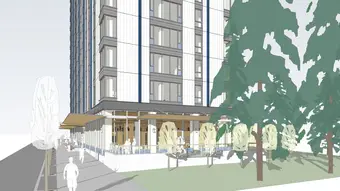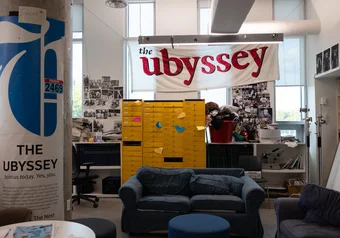In order for Brock Commons to succeed, it not only had to set a new bar for wood buildings, but also develop new methods for construction which streamlined the process and reduced the actual time spent on site. From the very beginning, efficiency without sacrificing safety was one of the key focuses of the project.
The initial budget for the project was $51,525,000. This put the building cost per square foot at $221, in comparison to a concrete building's average cost of $206 for the same area. The difference was termed the “innovation premium” which totaled a cost difference of eight per cent. This being a relatively new industry in Vancouver, a cost gap this size is not surprising. It is hoped that in the future, if wood construction becomes more prominent, the difference will close.
Long before a single hard-hat came anywhere near the site for Brock Commons, the project spent an intensive period in development. Unlike a typical concrete building, those involved were not only simply drawing up blueprints and calculating weight distribution, but also developing novel methods for constructing a building with methods not really put to the test before.
Unlike a typical design process where it begins with a team of architects and then escalates through various stages of review and testing, all major consulting parties, structural engineers, Cad programmers and other relevant parties were brought in to work as a team, ensuring that the final product was as best as possibly designed for constructibility.
Part of this process involved building a two-storey mock up in order to test construction methods. Cad virtual designers also used software typically utilized by automotive engineers to construct the building on the computer, with detail down to individual bolts. They used this software to not only test the plans, but also the process of construction. Effectively step by step, the entire construction process was choreographed in software long before the real thing ever was. This was the perfect way to ensure that when they actually were ready to start building, they knew it was going to be done in the most efficient way possible.
[Sorry, video not found. You can contact webmaster@ubyssey.ca to fix the issue]
Interestingly enough, though the design process was more intensive than a typical one, the the time it took to do so was no longer than a normal one.
With the design being complete, ground was broken on the site in November 2015, with the excavation of the foundation taking place between December and January. Afterwards, the foundation was set and construction of the elevator shafts began.
One of the greatest differences between concrete construction and wood is that concrete is mixed and laid on site, whereas the wood components of Brock Commons were prefabricated at the Structurlam factory in Okanagan Falls.
The wood materials are harvested from sustainable forests cultivated by the industry. They are then brought to the factory where they are made into panels which are laminated together and sealed in a water-resistant coating. The necessary metal components are then installed so that it can be later attached to the building frame, then they are put in containers and transported from the factory to the construction site.
This method has its advantages and disadvantages. The fact that concrete can be mixed on site makes it more adaptable to changing situations. However, prefabricated wood panels can be prepared ahead of time and transported in, meaning that when they arrive, they are quickly ready to be installed. This makes their construction sites comparably cleaner than ones heavily using concrete, with far less waste. When a panel or pillar arrives, it is lifted directly off the truck and set into place. It is also worth noting that a wood project utilizes significantly less trucks than a typical one, with less time spent idling as they wait to be unloaded.
The time it takes for a cross laminated timber (CLT) floor panel or glulam (glue-laminated) pillar to be installed can range from five to ten minutes from the ground to being bolted down. Furthermore, because the process of installing these components is remarkably simple, a team of only nine builders is needed for the process, which is remarkably smaller than a standard construction team.
These teams take approximately one week to place all of the necessary panels into place — a time frame which could have been made significantly faster if it weren't for safety regulations.
Not only did the assembly finish around two weeks ahead of schedule, it is estimated that by the time it is complete, it will have taken around four months or 20 per cent less time than a typical concrete building to construct.
Now that the the frame and exterior panels are done, workers will continue the process of coating the inside of the building in a layer of concrete and drywall to ensure that it meets fire safety codes. Already the studs are in place for the interior walls as well as some of the plumbing systems. The building should be ready for habitation some time in early 2017.
First online
Share this article








